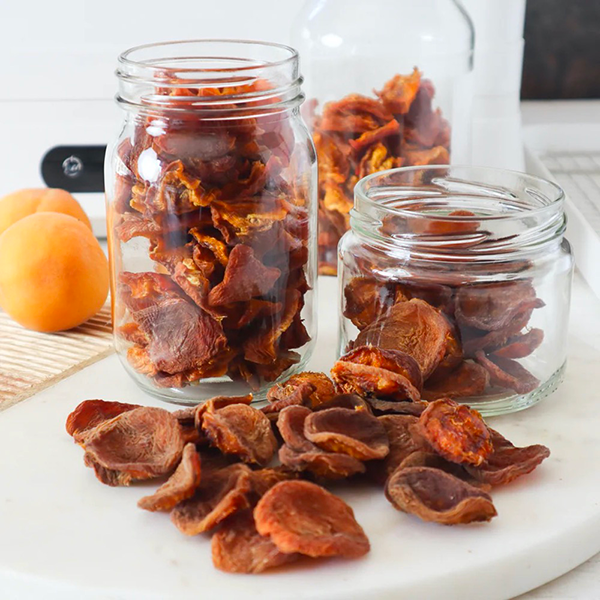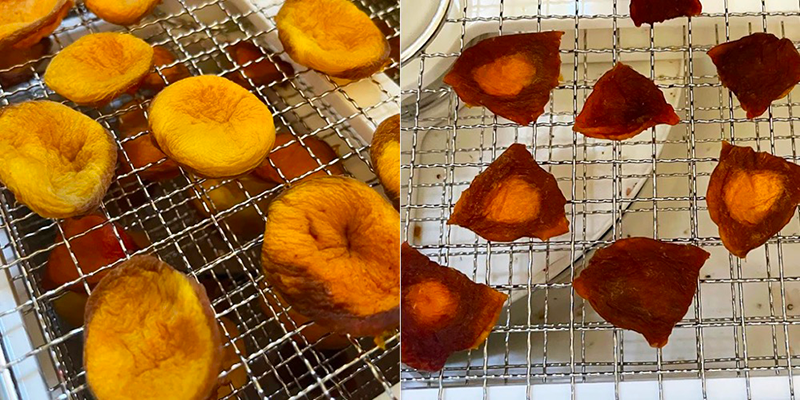
Content Menu
● Why Dehydrate Apricots?
● What You'll Need
● Step-by-Step Guide to Dehydrate Apricots
>> Step 1: Wash the Apricots
>> Step 2: Prepare the Apricots
>> Step 3: Soak in Lemon Water
>> Step 4: Dry the Apricot Halves
>> Step 5: Set Your Dehydrator
● Tips for Successful Dehydration
● How to Store Dried Apricots
● Ways to Use Dried Apricots
● Nutritional Benefits of Dried Apricots
● The Science Behind Dehydration
● Common Mistakes When Dehydrating Apricots
● Exploring Different Types of Dehydrators
● Advanced Techniques for Dehydrating Fruits
● Using Dried Apricots in Recipes
● Health Considerations When Consuming Dried Fruits
● Conclusion
● FAQ
>> 1. Why should I use a dehydrator instead of an oven?
>> 2. Can I dehydrate other fruits using this method?
>> 3. How do I know when my apricots are done?
>> 4. Is it necessary to soak apricots before dehydrating?
>> 5. Can I leave my food dehydrator on overnight?
● Citations:
Dehydrating apricots is a fantastic way to preserve their sweet flavor and nutritional benefits. Using a food dehydrator simplifies the process, allowing you to create delicious dried apricots at home with minimal effort. This article will guide you through the entire process of dehydrating apricots, including preparation, drying techniques, storage tips, and some frequently asked questions.

Why Dehydrate Apricots?
Dehydrating apricots not only extends their shelf life but also concentrates their flavors. Dried apricots make for a nutritious snack, can be added to various dishes, and are perfect for trail mixes. Furthermore, dehydrating fruits at home allows you to avoid preservatives often found in store-bought dried fruits.
What You'll Need
Before you start the dehydration process, gather the following materials:
- Fresh apricots (about 2 pounds)
- Food dehydrator
- Large bowl
- Colander
- Sharp knife
- Lemon juice (1 cup)
- Water (4 cups)
- Airtight storage containers
Step-by-Step Guide to Dehydrate Apricots
Step 1: Wash the Apricots
Begin by washing your apricots thoroughly in a bowl of water to remove any dirt or pesticides. Rinse them under cold water in a colander to ensure they are clean.
Step 2: Prepare the Apricots
Cut each apricot in half around the pit. Gently twist the halves apart and remove the pit. Place the halved apricots into a large bowl.
Step 3: Soak in Lemon Water
To prevent browning and enhance flavor, soak the apricot halves in a mixture of lemon juice and water for about 10 minutes. This step is crucial as it helps maintain the vibrant color of your dried fruit.
Lemon Water Mixture:
- 1 cup lemon juice
- 4 cups water
Step 4: Dry the Apricot Halves
After soaking, drain the apricot halves and pat them dry with paper towels. Arrange them skin-side down on the dehydrator trays, ensuring they are not touching each other for optimal airflow.
Step 5: Set Your Dehydrator
Set your food dehydrator to a temperature of 135°F (57°C). The drying time will vary depending on the size of your apricot halves but typically ranges from 12 to 24 hours. Check them periodically; they should be pliable but not sticky when done.

Tips for Successful Dehydration
- Uniform Size: Use apricots of similar size for even drying.
- Avoid Over-Drying: Check periodically to avoid making them too dry; they should still have some moisture inside.
- Airflow: Ensure there is enough space between apricot halves on the trays for proper air circulation.
How to Store Dried Apricots
Once your apricots are fully dehydrated, let them cool completely before storing. Place them in airtight containers or vacuum-sealed bags to keep moisture out. Store them in a cool, dark place where they can last for up to 6 to 12 months.
Ways to Use Dried Apricots
Dried apricots can be enjoyed in various ways:
- As a healthy snack on their own.
- Added to oatmeal or yogurt for breakfast.
- Incorporated into trail mixes or granola bars.
- Used in savory dishes like tagines or salads for a sweet contrast.
Nutritional Benefits of Dried Apricots
Dried apricots are not only delicious but also packed with nutrients:
- Rich in Vitamins: They are an excellent source of vitamins A and C, which are essential for maintaining healthy skin and vision.
- High in Fiber: Dried apricots contain significant amounts of dietary fiber, which aids digestion and helps maintain a healthy gut.
- Antioxidants: They are rich in antioxidants that help protect your body from free radicals and oxidative stress.
- Iron Content: Dried apricots provide iron, which is crucial for transporting oxygen in your blood and preventing anemia.
The Science Behind Dehydration
Dehydration works by removing moisture from food, which inhibits the growth of bacteria, yeast, and mold that can cause spoilage. The low heat used during dehydration helps preserve nutrients better than other methods like boiling or frying.
When fruits like apricots are dehydrated, their sugars become concentrated, enhancing their sweetness while reducing volume. This makes them an ideal ingredient for snacks and recipes where you want an intense flavor without excess moisture.
Common Mistakes When Dehydrating Apricots
To ensure successful dehydration, avoid these common pitfalls:
- Not Prepping Properly: Skipping washing or soaking can lead to poor texture and flavor.
- Overcrowding Trays: Placing too many pieces on one tray can prevent proper airflow and result in uneven drying.
- Ignoring Temperature Settings: Using incorrect temperatures can lead to either under-drying (which risks spoilage) or over-drying (which affects texture).
Exploring Different Types of Dehydrators
There are several types of food dehydrators available on the market:
- Stackable Tray Dehydrators: These are affordable options suitable for beginners. They consist of multiple trays stacked on top of each other with a heating element at the bottom.
- Shelf Dehydrators: These models have shelves that slide out like an oven rack and often come with fans that circulate air more evenly across all trays.
- Hybrid Dehydrators: These combine features from both stackable tray models and shelf models while offering advanced features like digital controls and timers.
Each type has its advantages depending on your needs—whether you're looking for portability or advanced features for consistent results.
Advanced Techniques for Dehydrating Fruits
For those looking to experiment further with their dehydrated fruits:
- Fruit Leathers: Puree fruits like apricots with a little water or lemon juice until smooth; spread thinly on dehydrator trays lined with parchment paper and dehydrate until flexible.
Basic Fruit Leather Recipe:
1. Blend 2 cups of fresh fruit (like ripe apricots) until smooth.
2. Spread evenly onto a nonstick dehydrator sheet.
3. Dehydrate at 135°F (57°C) for about 6–8 hours until no moisture remains.
- Flavor Infusions: Consider adding spices such as cinnamon or ginger during soaking to infuse additional flavors into your dried fruit.
Using Dried Apricots in Recipes
Dried apricots can enhance many recipes beyond snacking:
- Baked Goods: Incorporate chopped dried apricots into muffins or bread recipes for added sweetness and texture.
Apricot Muffin Recipe:
1. Preheat oven to 350°F (175°C).
2. Mix together 1 cup flour, ½ cup sugar, baking powder, salt.
3. Add one beaten egg, ½ cup milk, melted butter—mix well.
4. Fold in 1 cup chopped dried apricots.
5. Bake for about 20–25 minutes until golden brown.
- Savory Dishes: Use chopped dried apricots in salads or grain bowls for a sweet contrast against savory ingredients like feta cheese or roasted vegetables.
Health Considerations When Consuming Dried Fruits
While dried fruits like apricots offer numerous health benefits, moderation is key due to their concentrated sugar content:
- Be mindful of portion sizes; a small handful is typically sufficient as a snack.
- Pair dried fruits with nuts or yogurt to balance out sugars with protein and healthy fats for sustained energy release.
Conclusion
Dehydrating fruits such as apricots at home is not only simple but also allows you to explore various culinary applications while enjoying health benefits associated with dried fruits. By understanding different techniques and recipes involving dried fruits, you can make full use of your food dehydrator while indulging your taste buds throughout the year.

FAQ
1. Why should I use a dehydrator instead of an oven?
Using a dehydrator provides consistent temperature control and airflow, which helps achieve even drying without cooking the fruit, unlike many ovens that may not maintain low temperatures effectively.
2. Can I dehydrate other fruits using this method?
Yes! Many fruits such as apples, pears, and peaches can be dried using similar methods with slight variations in preparation time and temperature settings.
3. How do I know when my apricots are done?
Dried apricots should be pliable and not sticky. If they feel wet or overly soft, they need more time in the dehydrator.
4. Is it necessary to soak apricots before dehydrating?
Soaking is recommended as it prevents browning from oxidation and enhances flavor retention during drying.
5. Can I leave my food dehydrator on overnight?
Yes, most modern dehydrators are designed for extended use and can safely run overnight; just ensure you follow the manufacturer's guidelines regarding timing and temperature settings.
Citations:
[1] https://simpleveganblog.com/how-to-dehydrate-fruit/
[2] https://thenutmarket.com.au/blogs/health-benefits/how-to-dehydrate-fruit
[3] https://terradomilho.eu/2019/03/the-advantages-of-dehydrating-fruit-and-vegetables/
[4] https://melissaknorris.com/how-to-dehydrate-fruit/
[5] https://www.backpackingchef.com/dehydrating-fruit.html
[6] https://farmersmarketsnm.org/save-money-by-dehydrating-seasonal-fruits-and-vegetables-at-home/
[7] https://alittleinsanity.com/natural-fruit-chips-in-excalibur-dehydrator/
[8] https://www.youtube.com/watch?v=2RCRSi9AF5E
[9] https://www.webmd.com/diet/dehydrating-food-good-for-you
[10] https://www.freshoffthegrid.com/dehydrating-food/











